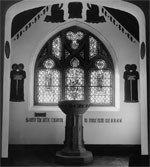In this Centennial Moments in History e-letter, you will read about the years 1929-1931 in the life of our parish. Where was the baptistery located in the newly expanded church, and why might that be of interest today? Who are some staff people who came to work in this period that would remain for decades, shaping the church we have inherited? Is it true that a staff member really lived in the top of the tower? Read on to discover the answers to these questions, and more.
Centennial Moments in History
1929-1931
No. 17
31 May 2012
The History of The Church of St. Michael & St. George (1928- )
Continuity Matters
Since we are surrounded by so great a cloud of witnesses, let us run with perseverance the race that is set before us, looking to Jesus the pioneer and perfecter of our faith.
- Hebrews 12:1-2a
The reconstructed buildings, discussed in last week's e-letter, were dedicated on 22 December 1929. The parish house was opened officially for the Annual Parish Meeting in January 1930. Four new vestrymen were elected, one of whom had served on the vestry of St. George's Church (1914-1928). The Rev. Raymond E. Brock, the last rector to serve St. George's Church, gave a talk at the meeting, and there was a reading of a telegram from the Rev. George E. Norton, the first rector of the Church of St. Michael and All Angels.
Prior to the reconstruction and enlargement, there had been no stained glass windows in the church. The original windows were of translucent diamond-shaped leaded glass in hues of lavender, green, beige rose, and white. Dr. Block consulted with Mr. Emil Frei, a stained glass window artisan in Munich, Germany, and they developed a plan in 1929 for memorial stained glass windows. The plan stated that memorial windows would be permitted in the chancel, chapel, and baptistery for the present time. On Palm Sunday, 13 April 1930, the memorial windows above the High Altar were dedicated. The dedication of other windows followed.
 | |
Baptistery after the church expansion of 1929.
|
Murals were placed in the baptistery in 1934. They were removed when the baptistery was torn out to make an entrance from the nave to the new St. George's Chapel constructed in 1998. Parishioners Dr. John D. Davidson (husband of Harriett Davidson, the author of Trilogy that is the history resource for many of these Centennial Moments in History e-letters) and John Koprowski salvaged the murals and stored them for future use.
There were significant and long-tenured staff additions in 1927, 1930, and 1931. Mr. Paul Friess became organist and choirmaster of the Church of St. Michael and All Angels in 1927 and continued in that position after the merger. He would remain for 36 years until 1963. He and his wife, Mary, were among the first music teachers at the Community Music School at 3833 Washington Boulevard. He later was executive director of the school for 15 years. In 1974 the school merged with the St. Louis Institute of Music to form the St. Louis Conservatory and School for the Arts (CASA). In 1994, CASA merged with the Saint Louis Symphony Orchestra and became the Saint Louis Symphony Community Music School. In September 2001, the Community Music School joined with Webster University, and in the fall of 2006, the school moved to its new headquarters on the Webster University campus.
In October 1929, Miss Elizabeth Dyer accepted the position of church school secretary and assistant treasurer. She was 58 years old, an age when most people begin to plan their retirement. "Miss Lizzie," as she was called, retired in May 1951 at the age of 80 after almost 22 years of service.
On 25 April 1931, Miss Martha Bishop came to work for Dr. Block on a temporary basis. Her temporary tenure continued for 41 years until she retired on 20 April 1972. Miss Bishop lived on the third floor of the Jay Herndon Smith Memorial Tower for 21 years (1944-1965). After her retirement she graced the church office with her presence on Sunday mornings as a volunteer, giving of her services to everyone as well as lending an air of graciousness, stability, and continuity. Her institutional memory was surely unexcelled even after her retirement.
Have you ever walked the interior walls of our church, contemplated what is pictured in the stained glass windows, and read the memorial plaques affixed to the walls and pillars? Do you think doing so might affect how connected you feel to the church and its people? Affect the manner in which you support the church and its people with your time, talent, and treasure?
We read above about three long-tenured positions at the church. We should add a fourth person from this era -- Dr. Block, who began as rector of St. Michael and All Angels in 1925 and will stay until 1938 (we will read in a later e-letter about the circumstances of his leaving). Consider your experience at our church and perhaps in previous churches. Would you say that vibrant churches usually do or do not require long tenures of well-qualified lay staff and clergy? To what degree, if any, is a church's momentum interrupted when there is frequent turnover in the clergy and lay staff?
I love thy kingdom, Lord,
The house of thine abode,
The Church our blest Redeemer saved
With his own precious blood.
For her my tears shall fall;
For her my prayers ascend;
To her my cares and toils be given,
Till toils and cares shall end.
- John R. Tyler
Historical information from Trilogy by Harriet Davidson
|